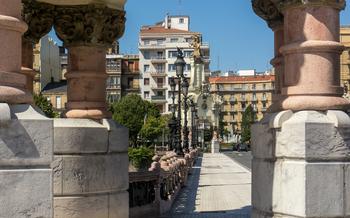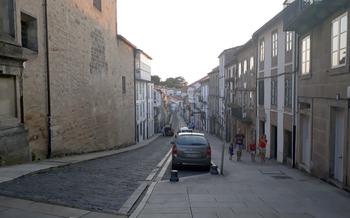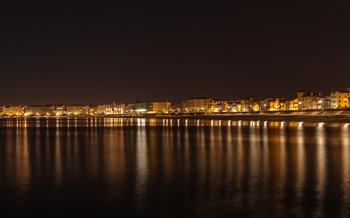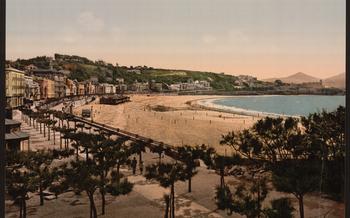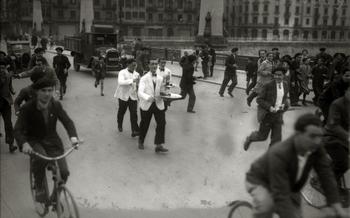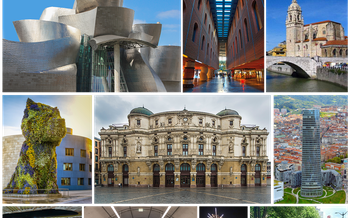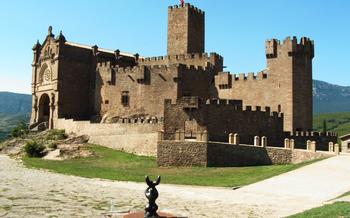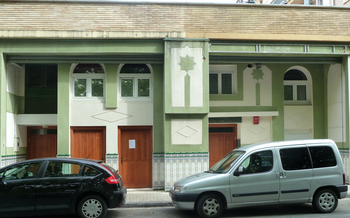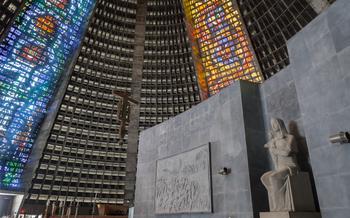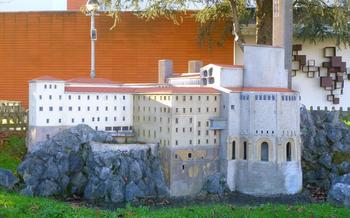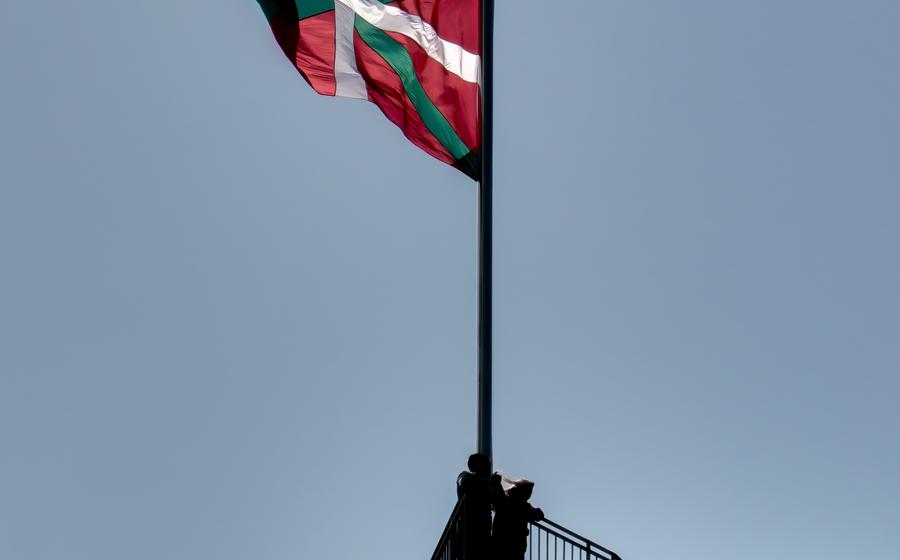
Loyola Sanctuary in Azpeitia
- The Loyola Sanctuary in Azpeitia: A Spiritual Haven
- Tracing the Footsteps of Saint Ignatius of Loyola
- Exploring the Sanctuary Grounds
- Inside the Basilica: Awe-Inspiring Architecture
- The Museum of the Sanctuary: Unveiling the Past
- Pilgrimage Routes to the Sanctuary
- Local Traditions and Celebrations
- Retreats and Spiritual Programs
- Surrounding Attractions: Azpeitia and Beyond
- Planning Your Visit: Practical Information
- Suggested Itinerary for a Day Trip
- Tips for a Meaningful Experience
- Photography and Social Media
- Accessibility and Facilities
- Insider Tip: Hidden Gems
The Loyola Sanctuary in Azpeitia: A Spiritual Haven
The Loyola Sanctuary, nestled in the heart of the Basque Country in Spain, is a profound spiritual haven that draws pilgrims and visitors from around the world. This sacred site is deeply intertwined with the life and legacy of Saint Ignatius of Loyola, the founder of the Society of Jesus (Jesuits). The sanctuary encompasses a stunning basilica, a museum, and serene gardens, offering a captivating journey into the life and spirituality of this influential saint.
The history of the Loyola Sanctuary dates back to the 16th century, when Ignatius of Loyola, a former soldier who underwent a profound spiritual transformation, founded the Society of Jesus in 153The sanctuary was built on the grounds of Loyola's birthplace, transforming it into a revered pilgrimage site. Over the centuries, the sanctuary has grown in prominence, becoming a symbol of Ignatian spirituality and a place of deep devotion for countless believers.
Tracing the Footsteps of Saint Ignatius of Loyola
In the heart of the Basque Country, the Loyola Sanctuary stands as a testament to the life and legacy of Saint Ignatius of Loyola, the founder of the Society of Jesus. Born into a noble family in nearby Azpeitia, Ignatius embarked on a remarkable journey that would transform him from a soldier into a spiritual leader.
After a life-changing injury during the Battle of Pamplona, Ignatius underwent a profound spiritual conversion. During his convalescence, he experienced a series of visions and mystical experiences that set him on a path of deep introspection and prayer. It was during this time that he began to develop the spiritual exercises that would later form the basis of Jesuit spirituality.
The sanctuary in Azpeitia holds immense significance in Ignatius's spiritual journey. It is here that he spent many years in prayer and meditation, seeking guidance and direction from God. The sanctuary became a place of profound spiritual growth for Ignatius, and it was here that he received the inspiration to found the Society of Jesus, which would go on to become one of the most influential religious orders in the world.
Ignatius's legacy lives on in the sanctuary, which continues to attract pilgrims and visitors from around the world who come to seek inspiration and guidance from his life and teachings. The sanctuary is a place of peace and reflection, where visitors can connect with the spirit of Ignatius and learn more about his remarkable journey of faith.
Exploring the Sanctuary Grounds
The Loyola Sanctuary complex is a harmonious blend of architectural marvels, serene gardens, and tranquil courtyards. At its heart stands the majestic Basilica of Saint Ignatius of Loyola, a testament to neoclassical grandeur. Flanking the basilica are several notable buildings and chapels, each with its own unique story to tell.
The House of the Pilgrim, a former residence for pilgrims, now serves as a spiritual and cultural center, hosting exhibitions, conferences, and workshops. The House of Retreats, a modern facility nestled amidst lush greenery, offers a serene environment for spiritual reflection and personal growth.
The gardens and courtyards of the sanctuary provide a peaceful retreat from the bustling world outside. The Garden of Remembrance, with its serene water features and commemorative plaques, honors the memory of those who have made significant contributions to the sanctuary and the Ignatian spirituality.
The Stations of the Cross, a series of sculptures depicting the Passion of Christ, offer a contemplative path for pilgrims and visitors to reflect on the life and sacrifice of Jesus. The Stations are beautifully integrated into the natural surroundings, creating a poignant and immersive experience.
Inside the Basilica: Awe-Inspiring Architecture
The Basilica of Saint Ignatius of Loyola stands as a testament to the grandeur and artistry of Neoclassical architecture. Its imposing facade, adorned with intricate carvings and sculptures, beckons visitors to step inside and marvel at its splendor. The interior of the basilica is equally breathtaking, with soaring ceilings, elaborate frescoes, and gleaming marble surfaces.
As you enter the basilica, your eyes are immediately drawn to the altarpiece, a masterpiece of Baroque art that depicts the life and martyrdom of Saint Ignatius of Loyola. The altarpiece is a testament to the skill and devotion of the artisans who created it, and it serves as a focal point for worship and contemplation.
Beneath the altar lies the crypt, where the remains of Saint Ignatius of Loyola are interred. Visitors can pay their respects at the tomb of the saint, which is adorned with intricate carvings and precious stones. The crypt is a place of pilgrimage for millions of Catholics worldwide, who come to seek inspiration and guidance from the life of Saint Ignatius.
The Museum of the Sanctuary: Unveiling the Past
Delve into the rich history and heritage of the Loyola Sanctuary by visiting its onsite museum. Here, you'll find a treasure trove of artifacts, relics, and interactive exhibits that shed light on the sanctuary's profound significance. Immerse yourself in the life and times of Saint Ignatius of Loyola through personal belongings, letters, and documents that offer a glimpse into his spiritual journey.
The museum's collection also features an array of religious art, including paintings, sculptures, and tapestries that depict scenes from the life of Ignatius and the history of the sanctuary. Multimedia displays and interactive exhibits bring the past to life, allowing you to experience the sanctuary's evolution and its impact on the local community.
Guided tours are available to provide deeper insights into the museum's collection and the sanctuary's history. Educational programs and workshops are also offered, catering to visitors of all ages and interests. Through these immersive experiences, the Museum of the Loyola Sanctuary invites you to explore the depths of faith, spirituality, and the enduring legacy of Saint Ignatius of Loyola.
Pilgrimage Routes to the Sanctuary
The Loyola Sanctuary in Azpeitia has been a popular pilgrimage destination for centuries, attracting devout Catholics from all over Spain and beyond. Pilgrims embark on spiritual journeys along various routes, each offering a unique experience.
One of the most popular routes is the Ignatian Way, a long-distance hiking trail that traces the footsteps of Saint Ignatius of Loyola. The trail begins in his birthplace of Azpeitia and winds through the picturesque Basque Country, passing through historic towns and villages. Along the way, pilgrims can visit other Ignatian sites, such as the Hermitage of La Antigua, where Ignatius experienced a profound spiritual conversion.
Other pilgrimage routes to the sanctuary include the Camino del Norte, a coastal path that follows the northern coast of Spain, and the Camino Francés, the most popular route of the Camino de Santiago. Regardless of the route chosen, pilgrims are rewarded with stunning scenery, rich cultural heritage, and the opportunity for spiritual reflection and growth.
Accommodations and facilities for pilgrims are available along the routes, ensuring a comfortable and safe journey. Whether walking alone or in groups, pilgrims can find hostels, guesthouses, and churches that offer lodging, meals, and spiritual guidance. The experience of walking in the footsteps of Saint Ignatius and connecting with fellow pilgrims creates a powerful sense of community and shared purpose.
Local Traditions and Celebrations
The Loyola Sanctuary is not only a sacred place of pilgrimage but also a vibrant center of local traditions and celebrations. The annual feasts and festivals held at the sanctuary are a testament to the deep devotion of the Basque people to Saint Ignatius of Loyola and their rich cultural heritage.
The most significant festival is the Feast of Saint Ignatius, celebrated on July 31st. The town of Azpeitia comes alive with a week-long program of events, including processions, concerts, fireworks, and traditional Basque dances. Pilgrims and visitors from all over the world gather to pay homage to the saint and participate in the festivities.
Another popular celebration is the Pilgrimage of the Cross, which takes place every September. Thousands of pilgrims carry a large wooden cross from the town of Oñati to the Loyola Sanctuary, a journey of over 50 kilometers. The procession is a symbol of faith and devotion, and it attracts participants from all walks of life.
During these festivals, the sanctuary is adorned with colorful decorations, and the air is filled with the sounds of music, laughter, and prayer. Visitors can savor traditional Basque cuisine, such as pintxos (small bites), txakoli (local wine), and Basque cheesecake, at the many food stalls and restaurants in the town. Participating in the local dances, music, and processions is a unique opportunity to immerse oneself in the vibrant culture of the Basque Country.
Retreats and Spiritual Programs
The Loyola Sanctuary offers a variety of retreats and spiritual programs designed to provide visitors with the opportunity for personal growth, reflection, and a deeper connection with their faith. These programs are led by experienced spiritual guides and retreat leaders who create a supportive and nurturing environment for participants to explore their inner selves and deepen their relationship with God.
Retreats at the sanctuary can range from a few days to several weeks, and they cover a wide range of topics, including Ignatian spirituality, meditation, prayer, and personal transformation. Participants engage in various activities, such as guided meditations, prayer sessions, spiritual readings, and group discussions, all aimed at fostering a deeper understanding of themselves and their relationship with the divine.
Whether you are seeking a quiet retreat to reconnect with your spiritual side or a more intensive program to explore your faith in greater depth, the Loyola Sanctuary offers a range of options to suit your needs. These programs provide a unique opportunity to step away from the distractions of daily life and immerse yourself in a transformative spiritual experience.
Surrounding Attractions: Azpeitia and Beyond
Beyond the spiritual allure of the Loyola Sanctuary, the surrounding area offers a wealth of attractions that enrich the pilgrimage experience. The historic town of Azpeitia itself is a treasure trove of cultural and historical landmarks. Explore the birthplace of Saint Ignatius of Loyola, a 16th-century farmhouse that has been transformed into a museum showcasing his life and legacy. Take a leisurely stroll through the town's charming streets, admiring the medieval architecture and vibrant Basque culture.
Venture beyond Azpeitia to discover the picturesque towns and villages of the Basque Country. Each destination offers its own unique charm, from the coastal beauty of Zarautz to the medieval streets of Hondarribia. Immerse yourself in the region's rich history, traditions, and gastronomy.
The Basque Country is also renowned for its stunning natural landscapes. Explore the rugged coastline, dotted with sandy beaches and dramatic cliffs. Hike through the verdant hills and valleys, discovering hidden waterfalls and breathtaking views. Whether you seek adventure or tranquility, the Basque Country offers a harmonious blend of spirituality and natural wonders.
Planning Your Visit: Practical Information
Getting to Azpeitia:
-
Azpeitia is easily accessible by public transportation. Trains and buses connect the town to major cities in the Basque Country and beyond.
-
If you prefer to drive, take the A-8 motorway and exit at Azpeitia. Ample parking is available near the sanctuary.
Accommodation:
-
There are several accommodation options near the sanctuary, ranging from hotels to guesthouses and apartments.
-
For a truly immersive experience, consider staying at the Hospedería del Santuario de Loyola, a former monastery converted into a modern guesthouse.
Visitor Center:
-
The sanctuary's visitor center provides valuable information and assistance to pilgrims and tourists.
-
Pick up maps, brochures, and guides to help you plan your visit.
Accessibility:
-
The sanctuary complex is wheelchair accessible, with ramps and elevators throughout the grounds.
-
Assisted listening devices are available for visitors with hearing impairments.
-
Guided tours in different languages can be arranged in advance.
Suggested Itinerary for a Day Trip
If you're planning a day trip to the Loyola Sanctuary in Azpeitia, here's a suggested itinerary to make the most of your visit:
-
Morning: Start your day by visiting the Basilica of Saint Ignatius of Loyola. Admire the stunning architecture, intricate carvings, and awe-inspiring interior. Don't miss the opportunity to attend a Mass or prayer service to fully immerse yourself in the spiritual atmosphere. Afterward, head to the Museum of the Sanctuary to delve into the history of the sanctuary and the life of Saint Ignatius of Loyola. The interactive exhibits and multimedia displays will provide a deeper understanding of the significance of this sacred place.
-
Afternoon: After lunch, explore the beautiful grounds of the sanctuary. Take a leisurely stroll through the serene gardens and courtyards, admiring the sculptures and fountains that adorn the landscape. Visit the other notable buildings and chapels within the complex, each with its own unique story to tell. In the afternoon, attend a Mass in the Basilica and soak in the spiritual energy that fills the air.
-
Evening: As the day winds down, join a guided tour of the town of Azpeitia to discover its rich history and connection to Saint Ignatius of Loyola. Visit the birthplace of the saint, the Loyola House, and learn about his early life and conversion. Immerse yourself in the local culture by participating in traditional Basque dances or enjoying a delicious dinner at one of the many restaurants in town.
Tips for a Meaningful Experience
To make the most of your visit to the Loyola Sanctuary, consider the following tips:
-
Attend a Mass or prayer service at the sanctuary. This is a wonderful way to connect with the spiritual atmosphere of the place and to experience the Ignatian spirituality firsthand.
-
Light a candle and offer prayers at the tomb of Saint Ignatius. This is a deeply moving experience that allows you to pay your respects to the founder of the Society of Jesus and to seek his intercession.
-
Take some time for quiet reflection and meditation. The sanctuary offers many peaceful spots where you can sit in silence and contemplate the beauty of the surroundings.
-
Engage with the local community and learn about their traditions. The people of Azpeitia are proud of their heritage and are happy to share it with visitors. Take the time to talk to the locals, visit the local markets, and sample the delicious Basque cuisine.
Photography and Social Media
Photography and Social Media
As you explore this sacred site, capturing the beauty and spirituality of the Loyola Sanctuary through photography is a wonderful way to preserve your memories. However, it's important to respect the sanctity of the space and follow the photography guidelines. Avoid using flash or tripods inside the Basilica and be mindful of other visitors during your photography sessions.
Share your experiences on social media to inspire others to embark on their journey of faith. Use relevant hashtags like #LoyolaSanctuary, #SaintIgnatius, and #BasqueCountry to connect with a global community of pilgrims and travelers. Tagging the sanctuary's official social media accounts will allow them to feature your content and share your unique perspective with their followers.
Remember, the Loyola Sanctuary is a place of deep spiritual significance, and respecting its sacredness while capturing its essence through photography will enhance your overall experience.
Accessibility and Facilities
The Loyola Sanctuary is dedicated to ensuring accessibility for visitors with disabilities. Wheelchair ramps and elevators provide easy access to all levels of the complex, including the Basilica, the Museum, and the outdoor grounds. Accessible restrooms are available throughout the sanctuary, and designated parking spaces are reserved for visitors with disabilities.
In addition, the sanctuary offers a variety of services to cater to the needs of pilgrims and visitors with special requirements. Guided tours in sign language and audio descriptions of the sanctuary's highlights are available upon request. The sanctuary staff is committed to providing a welcoming and inclusive environment for all visitors, ensuring that everyone has the opportunity to experience the spiritual and historical significance of this sacred place.
Insider Tip: Hidden Gems
Beyond the main attractions of the Loyola Sanctuary, there are hidden gems waiting to be discovered by curious travelers. For those seeking a unique experience, here are some insider tips:
-
Secret Passageway in the Basilica: Uncover the hidden passageway within the Basilica, a secret route once used by the Jesuits to move discreetly between different parts of the complex. Ask a guide or a member of the staff to show you the way.
-
Hermitage of La Antigua: Just a short walk from the sanctuary, find the Hermitage of La Antigua, a charming 13th-century chapel. This hidden gem offers tranquility and a glimpse into the region's rich history.
-
Ignatian Way Hiking Trail: For those who enjoy outdoor adventures, embark on the Ignatian Way hiking trail, a scenic route that follows the footsteps of Saint Ignatius of Loyola. Experience the natural beauty of the Basque Country while retracing the saint's journey.
-
Traditional Basque Dance Class: Immerse yourself in the local culture by joining a traditional Basque dance class. Learn the lively steps and rhythms of these traditional dances, a delightful way to connect with the Basque heritage.
